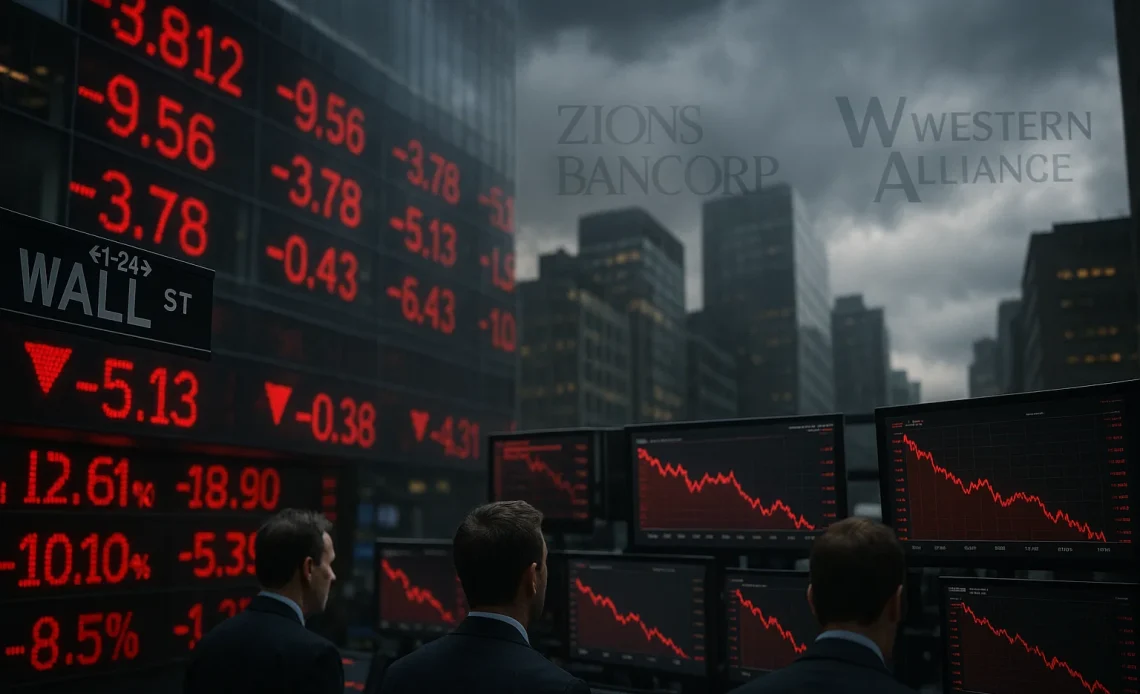Zions Bancorp announced a $50 million charge-off on two troubled loans at its California Bank & Trust unit, while Western Alliance Bancorp revealed it is suing a borrower for alleged fraud.
These developments rattled the regional banking sector, sending both stocks tumbling more than 10% intraday.
The turmoil triggered broader selling in regional-bank ETFs and pressured Wall Street futures, fueling growing investor concerns about credit quality in regional banks.
Immediate shock: loan loss and fraud suit rattle regional banks
Zions Bancorp took a significant $50 million charge-off in its third-quarter results related to two commercial and industrial loans totaling approximately $60 million at its California Bank & Trust division.
The loans involved apparent misrepresentations and contractual defaults uncovered during an internal review.
Meanwhile, Western Alliance Bancorp filed a lawsuit in August against borrower Cantor Group V, LLC, accusing the group of fraud by failing to provide collateral loans in the first position.
Despite the suit, Western Alliance remains confident that existing collateral sufficiently covers the debt and reaffirmed its 2025 guidance.
The allegations involve loans tied to investment funds linked to individuals Andrew Stupin and Gerald Marcil, connected to distressed commercial mortgage loans.
The market reacted swiftly as shares of Zions and Western Alliance plunged 12% and 11% respectively, dragging down the broader regional banking ETF by around 6%.
Key US indices such as the Dow and S&P 500 futures also retreated amid growing concerns over the health of regional banks.
Analysts at Stephens Inc. and Piper Sandler have highlighted renewed credit quality worries, emphasizing that investors are not overlooking these emerging risks.
Why Wall Street is so volatile?
This latest shock to regional banks emerges amid a backdrop of mounting credit stress and rising defaults in niche sectors such as autos and parts suppliers, most notably observed in the bankruptcy of First Brands.
US regional banks’ exposure to these fragile borrowers, including some operating through private or shadow banking channels, has sparked fears of contagion due to opaque lending practices often involving off-balance-sheet financing.
Analysts and regulators have expressed concern over the limited visibility into these riskier credit facilities and the potential for hidden losses to spread throughout the banking system.
The market reaction to Zions’ charge-off and Western Alliance’s fraud suit exemplifies how even isolated events can snowball into sector-wide fear.
Such developments lead to a repricing of credit risk, prompting investors to reconsider the valuations of regional banks.
Additionally, worries about deposit flight and rising funding costs add to the pressure, further complicating banks’ strategic outlooks.
However, it is important to note that some banks still report healthy financial metrics and growth trajectories, and Western Alliance has reaffirmed its 2025 guidance amid these concerns.
The debate thus centers on balancing the evidence of isolated credit events against broader resilience in the sector.
Investors will closely monitor upcoming quarterly earnings, further loan-loss disclosures, and regulatory commentary for signals on credit quality and risk exposure.
These factors will be critical in assessing the regional banking sector’s near-term stability and market direction.
The post What did Zions Bancorp & Western Alliance do, and why is Wall Street so volatile? appeared first on Invezz







